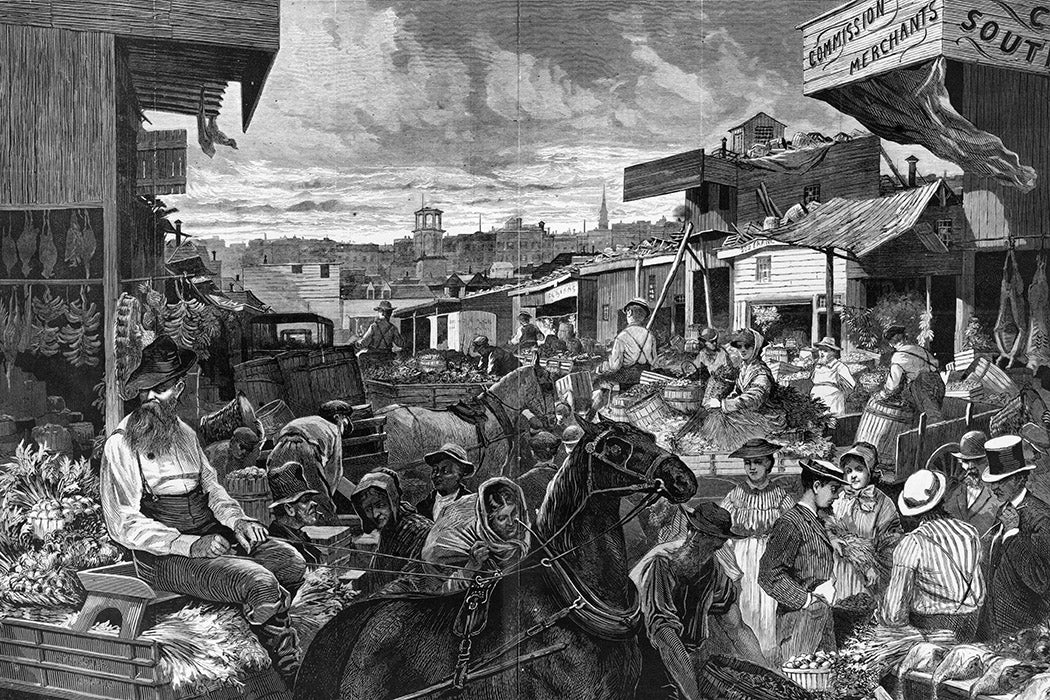Supplying food to urbanites involves a complicated network of farms, processors and manufacturers, transportation systems, and final distribution from warehouses and wholesalers to the local stores. Most of the enormous process isn’t generally a matter of urban policy, but distribution certainly is. Before the Civil War, American cities were often characterized by centralized, municipal food provisioning.
Cities like New York operated sophisticated and “tightly managed municipal marketplaces to ensure the proper provisioning of residents,” writes historian Gergerly Baics. Food was considered a public good, “to be sustained by active government involvement” in “fair trade practices and basic standards of food quality.”
Baics examines the situation in New York, meaning Manhattan, where a municipal marketplace system existed between 1790 and 1860. “The three parties of the municipal model […] all kept their gaze on the daily transaction of food vendors and customers,” Baics writes.
“Market officials were assigned to monitor everyday retail practices and quality to enforce the market laws’ standards; vendors constantly kept an eye on each other to protect their businesses from unfair competition; and customers, on their part, compared the same provisions across different retailers.”
It was initially the regulation of the fresh meat trade—only licensed butchers could sell veal, beef, lamb, mutton, and pork from municipal marketplaces—that gathered or agglomerated food retailers to these city marketplaces dotting lower Manhattan. All the other vendors wanted to be near the butchers for a simple reason: before refrigeration, meat was generally bought for that day’s use, and shoppers, not unlike today, liked to get everything they needed from one convenient place.
From 1790 to the mid-1820s, New York’s population grew from around 30,000 to more than 150,000. At first, the city’s Common Council expanded public market infrastructure to accommodate the growing demand and the spread of residents and real estate. For example, Washington Market on the west side of lower Manhattan was set up in 1812; Essex Street in what later became the Lower East Side had a covered marketplace by 1818.
The growing city was resulting in longer distances to markets for customers, but this was initially offset by the time savings inherent in making all purchases in one location.
This system only worked, Baics argues, if the “principles of dispersal and agglomeration were consistently kept in balance with urban growth.” It began to slowly unravel when city officials stopped allocating “adequate resources to guarantee its proper functioning.” Changing municipal priorities and the consequent slackening of social investment meant the food provisioning infrastructure couldn’t keep pace with urban growth.
The city’s population reached 300,000 in the mid-1840s, half a million by mid-century. Yet no new markets were built after 1837. A few of the smaller ones were actually shut down in the 1840s. Unlicensed vendors proliferated to meet demand. (A century later, crowds of pushcart vendors clogging streets inspired another cycle of publicly built marketplaces, including a new Essex Street Market that opened in four buildings, with 475 vendors, in 1940.)
The big blow came with the deregulation of the meat trade in 1843. This undermined the main reason for public markets in the first place—safe meat products. Suddenly, butchers no longer needed licenses and could sell anywhere. The proliferation resulting from this deregulation was the subject of much public debate, but the private market won.
Weekly Newsletter
“Urban provisioning gradually shifted to the private domain,” a process largely complete by the beginning of the Civil War. As Baics summarizes, “the history of nineteenth-century New York’s municipal market system recalls the fate of so many other public services, where insufficient social investments are mistakenly interpret as evidence of the intrinsic failure of government provisions.”
Some of these foundational markets turned into wholesale centers. Washington Market became the largest wholesaler of fresh produce in the city before that function was relocated to Hunt’s Point in the Bronx in 1962. Fulton Market, just a few blocks east of Wall Street, specialized in fresh fish until new facilities opened in the Bronx in 2005.
Support JSTOR Daily! Join our new membership program on Patreon today.







